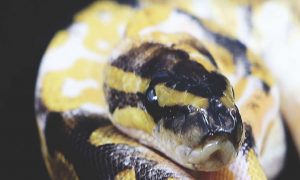Of the many fabulous creatures of Greek mythology, the chimera has to be one of the wildest flights of fancy. Images in pottery, gold jewelry, and bronze figures show this monster to have the head and body of a male lion, with the head of a goat rising from its torso and a tail that ends in either a serpent’s or snake’s head.
So embedded has the idea of a mix-and-match creature become in Western culture that the term “chimera” has passed into science—and specifically, into genetics—to refer to a single organism that is actually composed of cells originating from different fertilized eggs. The result is a mouse, human, anglerfish, or marmoset whose organs or tissues might possess different sets of chromosomes.
Depending on the organism, a chimera might have to deal with health problems or, in the case of human beings who exhibit chimerism, legal difficulties as well—or a chimera may simply be a rare and unusual individual, such as a male cat exhibiting tortoiseshell coloration in its fur.
A SPECIAL HYBRID
This is the idea behind the equally rare and unusual chimera ball python. What is a chimera ball python? Simply put, it is a specimen of Python regius that has two sets of DNA in its cells.
How rare is the chimera ball python? According to Pitlair, the local expert we consulted (and who provided the specimen you see here), they’re rare enough that they might be better referred to as happy accidents, or as pleasant surprises. He’s been breeding ball pythons for a long time now, and in his considerable experience, while there are large numbers of ball pythons hatched all over the world each year, only a bare handful of chimeras have ever emerged.
In general, ball pythons make wonderful pets. They are docile for the most part, and relatively small, especially when compared to other non-venomous snakes. They thrive in most types of substrates or beddings, bar the few that might be actively harmful to them, such as cedar chips. Paper towels are recommended, and, where they’re available, pine or aspen shavings.
So what’s the difference between a regular ball python and a chimera ball python? Pitlair says that being a chimera has no real effect on the overall health or well-being of the snake. It’ll grow up to about four feet long, as with regular ball pythons. It’ll live for about twenty years, also as with regular ball pythons.
And to make sure that it grows into a happy and healthy adult, a chimera ball python is cared for in much the same way as any other ball python.

The chimera ball python that currently lives in its own little nest in Pitlair’s home seems to have genetic material that codes for the recessive trait of albinism, accounting for the unique coloration and patterns on its scales. Otherwise, it’s just like most other ball pythons: some are more tolerant of being handled compared to others.
Ball pythons are generally not prone to biting, which is, again, the norm; when they’re frightened, however, or don’t want to be held, they will just curl up into tight little balls. Some ball pythons may be flighty when they’re picked up, but with regular handling, they may settle down and get used to being held.
Feeding a chimera ball python is not so very different from feeding a regular ball python, as Pitlair has found. He feeds it fresh, just-killed rodents, but that’s only because he doesn’t have a supply of frozen rodents. It’s better to offer dead prey rather than living if the ball python will eat them, because then that minimizes the risk of a live rodent biting the snake that’s supposed to be eating it.
According to Pitlair, it’s pretty easy to keep ball pythons as pets in the Philippines, thanks to the relatively warm temperatures and humid, tropical environment. It would be wise, however, to protect the ball python from extreme or sudden spikes or drops in temperature. Also, make sure that clean water is available at all times.
Pitlair prefers to offer his chimera ball python fresh and unused newsprint for bedding, laid in an even layer in a plastic tub of about 17” by 32” by 6”. This gives the ball python plenty of room to move around. Newsprint, which is the paper on which newspapers are usually printed, does a good job of absorbing the ball python’s wastes, and is both inexpensive and readily available.
Caring for a chimera ball python, as with any other ball python, is easy as long as the breeder or owner keeps a few reasonable guidelines in mind. To avoid getting attacked by his chimera, Pitlair makes sure to wash his hands thoroughly before picking it up, so that his hands don’t smell like prey to the ball python. He also tends to pick his chimera ball python up from behind—and he never picks it up when it’s just finished a meal. Again, this is so that it doesn’t perceive him as prey.
A chimera ball python stands out in the world of breeding snakes as companion animals because of two things: its sheer rarity, and the fact that if it should be bred, there’s really no way of knowing which set of genetic material will be passed on to its offspring. In Pitlair’s case, he’ll need to breed his chimera and see if he gets any albino ball pythons in the next generation. It’ll be interesting to find out what happens next to this rare and dazzling specimen.
This appeared in Animal Scene’s November 2016 issue.






